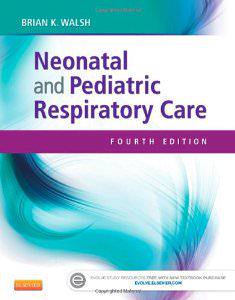Instant download Test Bank for Neonatal and Pediatric Respiratory Care 4th Edition Brian K Walsh Download pdf docx epub after payment.

Product details:
- ISBN-10 : 145575319X
- ISBN-13 : 978-1455753192
- Author:
- A comprehensive text on respiratory care for neonates, infants, and children, Neonatal and Pediatric Respiratory Care, 4th Edition provides a solid foundationin the assessment and treatment of respiratory care disorders. Clear, full-color coverage emphasizes clinical application of the principles of neonatal/pediatric respiratory care. New to this edition is coverage of the latest advances in clinical practice, a chapter devoted to quality and safety, and summary boxes discussing real-world clinical scenarios. From author Brian Walsh, an experienced educator and respiratory therapist, this text is an excellent study tool for the NBRC’s Neonatal/Pediatric Specialty exam!
Table of contents:
- Contributors
- EVOLVE CONTRIBUTOR
- Reviewers
- Preface
- Audience
- New to this edition
- Learning AIDS
- Evolve resources—http://evolve.elsevier.com/walsh/neonatal
- For the instructor
- For students
- Acknowledgments
- SECTION I Fetal Development, Assessment and Delivery
- Chapter 1 Fetal lung development
- Learning objectives
- Key terms
- Phases of lung development
- TABLE 1-1 Classification of Phases of Human Intrauterine Lung Growth
- Embryonal phase
- Pseudoglandular phase
- FIGURE 1-1 Embryonal stage of lung development. A to C, The trachea and major bronchi at 4 weeks; D and E, 5 weeks; F, 6 weeks; G, 8 weeks.
- Canalicular phase
- Saccular phase
- Alveolar phase
- FIGURE 1-2 Canalicular stage of lung development at 22 weeks of gestation. A terminal bronchiole (bottom left) leads into a prospective acinus. Note that branches are sparse.
- FIGURE 1-3 Saccular stage of lung development at 29 weeks of gestation. Secondary crests (arrows) begin to divide saccules into smaller compartments.
- FIGURE 1-4 Alveolar stage of lung development at 36 weeks of gestation. Note the double capillary network (solid arrows, center and right) and the single capillary layer (arrow at left).
- FIGURE 1-5 Alveolar stage of lung development at 36 weeks of gestation: Thin-walled alveoli are present.
- Postnatal lung growth
- Factors affecting prenatal and postnatal lung growth
- Abnormal lung development
- Pulmonary hypoplasia
- Alveolar cell development and surfactant production
- Fetal lung liquid
- Key points
- Assessment questions
- References
- Chapter 2 Fetal gas exchange and circulation
- Learning objectives
- Key terms
- Embryological overview
- Fertilization to implantation
- Box 2-1 Origin of the Various Tissue Systems from the Three Embryonic Germ Layers
- Ectoderm
- Mesoderm
- Endoderm
- Maternal–fetal gas exchange
- FIGURE 2-1 Implanted human embryo, approximately day 28, showing the relationship of the chorion, amnion, and chorionic villi. The umbilical cord and tail are difficult to differentiate in this view.
- Cardiovascular development
- Early development
- TABLE 2-1 Timetable of Significant Events During Fetal Heart Development
- Chamber development
- FIGURE 2-2 Formation of the primordial heart chambers after fusion of the heart tubes at a gestational age of 3 weeks.
- Maturation
- Fetal circulation and fetal shunts
- FIGURE 2-3 A, Sagittal view of the developing heart during week 4, showing the position of the atrium, bulbus cordis, ventricles, and endocardial cushions merging from the ventral and dorsal sides. B, Traditional view of the developing heart during weeks 4 to 5, showing budding interventricular septum, fused endocardial cushions, septum primum, and the left and right atria. The ventricular septum continues to fold and grow upward between the ventricles.
- FIGURE 2-4 Frontal view of the fetal heart between weeks 5 and 6, showing the development of the four chambers nearing completion. The arrow shows the one-way path through the foramen ovale.
- FIGURE 2-5 Frontal view (right) and side view (left) schematics of the foramen ovale. The septum primum forms the flap, and the septum secundum remains open to form the foramen ovale. The arrows show the one-way path through the foramen ovale.
- FIGURE 2-6 A diagram of the fetal circulation showing blood containing oxygen and nourishment moving from the placenta to the fetal heart and through the three fetal shunts: the ductus venosus, the foramen ovale, and the ductus arteriosus.
- Transition to extrauterine life
- CASE STUDY Prematurity-Associated Respiratory Distress
- Key points
- Assessment questions
- References
- Chapter 3 Antenatal assessment and high-risk delivery
- Learning objectives
- Key terms
- Maternal and perinatal disorders
- Diabetes mellitus
- Pregestational diabetes mellitus.
- Gestational diabetes mellitus.
- TABLE 3-1 Criteria for the Diagnosis of Diabetes Mellitus Using Oral Glucose Tolerance Testing
- Infectious diseases
- Group B Streptococcus
- Herpes simplex virus
- Human immunodeficiency virus and hepatitis B virus
- HIV.
- HBV.
- Toxic habits in pregnancy
- Alcohol
- Smoking
- Cocaine
- Other substances
- High-risk conditions
- Hypertension and preeclampsia
- Box 3-1 Predisposing Factors for the Development of Preeclampsia
- Box 3-2 Criteria for the Diagnosis of Severe Preeclampsia
- Fetal membranes, umbilical cord, and placenta
- Disorders of amniotic fluid volume
- Preterm birth
- TABLE 3-2 Infant Mortality Rates in the United States, 2008
- Box 3-3 Medical Risk Factors Associated with Preterm Labor and Delivery
- FIGURE 3-1 A pie chart of the four most common reasons for preterm birth.
- Cervical insufficiency
- Postterm pregnancy
- FIGURE 3-2 Ultrasound picture of a fetus at 23 weeks of gestation (top), with a Doppler study of the fetal heart (bottom). Dop, Doppler; Fr, frame; Freq, frequency; PRF, pulse-repetition frequency; SV, sample volume; WF, wall filter.
- Antenatal assessment
- Ultrasound
- Amniocentesis
- Nonstress test and contraction stress test
- FIGURE 3-3 In amniocentesis, a needle is inserted through the expectant mother’s abdomen to aspirate fluid from the amniotic sac. The fluid can then be tested to detect chromosomal abnormalities in fetal cells or other problems and to determine fetal lung maturity.
- Fetal biophysical profile
- Mode of delivery
- Breech presentation
- FIGURE 3-4 A nonstress test recording, produced with a cardiotocograph. A, The fetal heart rate (FHR) is recorded with an ultrasound probe as changes in beats per minute (bpm) over time. B, Uterine contractions (UC) are recorded with a pressure transducer as changes in pressure (mm Hg) over time. In this case the nonstress test is reactive, indicating normal uteroplacental function.
- TABLE 3-3 Biophysical Profile Scoring
- Assisted vaginal delivery
- Cesarean delivery
- Transient tachypnea of the newborn/type II respiratory distress syndrome
- Intrapartum monitoring
- FIGURE 3-5 Early decelerations (coinciding with uterine contraction) usually are due to fetal head compression and pose little threat to the fetus.
- FIGURE 3-6 Variable decelerations are the most common. They are due to cord compression and have different configurations. Repetitive severe variable decelerations are associated with increased risk of fetal hypoxia.
- FIGURE 3-7 Late decelerations are due to uteroplacental insufficiency. They usually begin at the peak of the contraction and are associated with fetal distress.
- TABLE 3-4 Normal Values for Fetal Scalp Blood and Umbilical Cord Blood Gases
- Fetal transition to extrauterine life
- CASE STUDY
- Key points
- Assessment questions
- References
- SECTION II Assessment and Monitoring of the Neonatal and Pedicatric Patient
- Chapter 4 Examination and assessment of the neonatal and pediatric patient
- Learning objectives
- Key terms
- Stabilizing the neonate
- Drying and warming
- Clearing the airway
- Box 4-1 Perinatal Factors Associated with Increased Risk of Neonatal Depression
- Antepartum (fetomaternal)
- Intrapartum
- FIGURE 4-1 Radiant warmer.
- FIGURE 4-2 Meconium aspirator.
- Providing stimulation
- Apgar score
- TABLE 4-1 Apgar Scoring
- Gestational age and size assessment
- Physical examination of the neonate
- Vital signs
- General inspection
- FIGURE 4-3 New Ballard score.
- Respiratory function
- FIGURE 4-4 Weeks of gestation.
- TABLE 4-2 Normal Values for Vital Signs in the Neonatal Patient
- FIGURE 4-5 Left-sided brachial plexus.
- FIGURE 4-6 Mongolian spot.
- TABLE 4-3 Common Dermal Findings in the Neonatal Patient
- TABLE 4-4 Signs of Respiratory Distress in the Neonatal Patient
- FIGURE 4-7 Silverman score.
- Chest and cardiovascular system
- Abdomen
- Head and neck
- FIGURE 4-8 A, Gastroschisis. B, Omphalocele.
- Musculoskeletal system, spine, and extremities
- FIGURE 4-9 Infant with spina bifada.
- FIGURE 4-10 A, Myelomeningocele with intact sac. B, Myelomeningocele with ruptured sac.
- Cry
- Neurological assessment
- Pediatric patient history
- FIGURE 4-11 Moro reflex.
- Chief complaint
- New patient history
- Follow-up or established patient history
- Box 4-2 New Patient History
- Chief complaint or primary reason for visit
- Medical history
- Review of symptoms
- Box 4-3 Follow-up or Established Patient History
- Chief complaint or previous diagnosis or problem
- Interim history
- Review of key components
- Pulmonary examination
- Box 4-4 Pulmonary Examination
- Inspection
- TABLE 4-5 Normal Respiratory Rates in Sleeping and Awake Pediatric Patients
- FIGURE 4-12 Head bobbing.
- FIGURE 4-13 Intercostal retractions. Soft tissue between the ribs is pulled inward (retracted) because of the extremely high negative pleural pressure.
- FIGURE 4-14 Suprasternal retractions. Soft tissue in the suprasternal space is retracted because of high negative pressure, most often caused by the patient’s attempt to breathe against an airway obstruction.
- FIGURE 4-15 Subcostal/substernal retractions. Airway obstruction results in a pulling inward of the lower costal margins. The abdomen is protruding (1), and there is a sunken substernal notch (2). See-saw movement of the chest and stomach is also present.
- Palpation
- FIGURE 4-16 Technique for determining tracheal position in the older child.
- Percussion
- Auscultation
- Nonpulmonary examination
- Box 4-5 Nonpulmonary Examination: Findings Possibly Associated with Pulmonary Disease
- General
- Ears, eyes, nose, throat
- Heart
- Abdomen
People also search:
Neonatal and Pediatric Respiratory Care 4th Edition
Neonatal and Pediatric Respiratory Care 4th Edition pdf
Neonatal and Pediatric Respiratory Care





